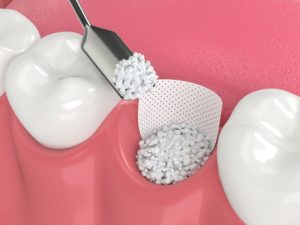
Dental implants are the best form of tooth replacement, but since they involve a complex treatment process, not everyone is immediately eligible to receive them. In fact, it is common for patients to require one or more preliminary procedures in advance of their dental implant surgery. If that is true in your case, do not be discouraged — although these services can extend your treatment timeline, they will play a role in helping your new smile to be strong and successful. What are some of the most common preliminary procedures? This blog post explains.
Gum Disease Therapy
Gum disease is a leading cause of tooth loss, so it stands to reason that many potential dental implant candidates have it. Because it could interfere with the success of your new teeth, it must be treated before you move forward with rebuilding your smile. Your general dentist or a periodontal specialist will likely be the one to provide your needed care, which may involve a deep cleaning of the mouth, removal of diseased tissue, and other measures.
Tooth Extractions
If your remaining natural teeth are no longer healthy, it might be wise to extract them before you receive dental implants. By getting them removed, you can clear the way to receive a full-arch implant denture, which can repair your smile in the most efficient way possible. In some cases, it is even advisable to remove healthy teeth in order to make room for an implant-supported restoration.
Bone Graft
After the natural teeth are lost, the jawbone begins to deteriorate. It might even become so small and weak that it cannot support dental implants. For such patients, a surgical procedure known as a bone graft is often necessary. During the treatment, bone material — perhaps from a donor or another part of the patient’s own body — is added to the jawbone, helping it to become stronger and larger.
There are several different types of bone grafts, so you will need to ask your oral surgeon for specific details of your procedure. Often, patients can receive dental implants several months after a successful bone graft.
Sinus Lift
A sinus lift is a special type of bone graft. It is necessary when the upper jaw is too thin; placing implants in it would cause them to penetrate the sinus membrane. As its name implies, a sinus lift involves moving the sinus upward and placing new bone material beneath it. After a healing period, it should be safe to place dental implants.
The process of replacing your teeth with dental implants could involve several steps and multiple procedures. Be patient, trust your oral surgeon, and look forward to a strong and healthy smile!
Meet the Practice
Drs. Koo, Weil, and Shepard are the three board-certified oral surgeons at Piney Point Dental Implant Center. Along with our dedicated support staff, they provide a broad range of services to help patients rebuild their lost teeth, including dental implant placement and a number of preliminary procedures. To learn how we may be about to help you replace your lost teeth, contact our Houston office at 713-597-7340.

